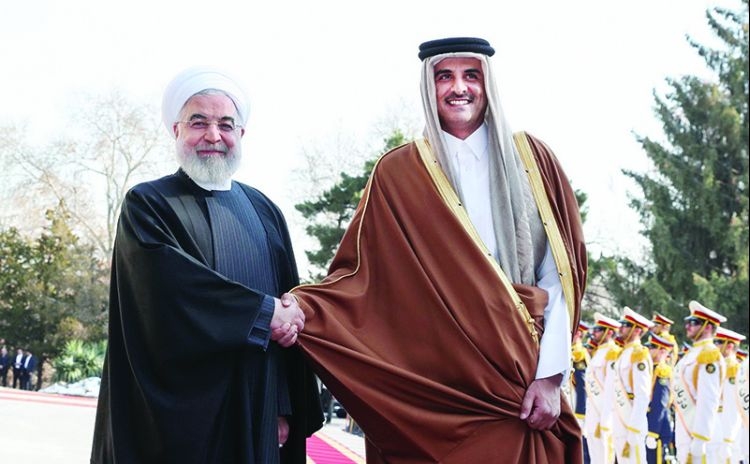Qatar, Iran agree de-escalation ‘only solution’ to resolve crisis
International Published on: 13 January, 2020 @ 1:40 PM
Qatar and Iran agree that de-escalation is the “only solution” to regional tensions, Qatari Amir Sheikh Tamim bin Hamad Al-Thani said yesterday after meeting Iran’s President Hassan Rouhani in Tehran.
“This visit comes at a critical time in the region, and we agreed with the brothers and with His Excellency the president that the only solution to these crises is de-escalation from everyone and dialogue,” he told a news conference. “Dialogue is the only solution” to resolve the crises, he said at a time of heightened US-Iranian tensions following the US killing of an Iranian commander and retaliatory strikes.
Qatar is close to the US and hosts Washington’s largest military base in the region, but it also enjoys strong ties with Tehran, with which it shares the world’s largest gas field. Sheikh Tamim arrived in the Iranian capital around midday, semi-official news agency ISNA said. Qatar’s Foreign Minister Mohammed bin Abdulrahman Al-Thani reportedly called for a peaceful solution that would lead to de-escalation during a visit to Tehran in the immediate aftermath of the US strike on Jan 3.
Sheikh Tamim left Doha for Muscat yesterday morning “to offer condolences on the death of Sultan Qaboos”, the state-run Qatar News Agency reported. His visit – believed to be his first official visit to the Islamic republic – follows the US killing of Iranian general Qasem Soleimani in a US drone strike near Baghdad’s airport, and Iran’s admission it accidentally shot down an airliner near Tehran on Wednesday.
Iran retaliated against the US for Soleimani’s death by firing missiles at American troops in Iraq, which US President Donald Trump said caused no casualties. Qatar’s relationship with Iran, seen as the major regional rival to Saudi Arabia, is one of the major factors underpinning a crisis between Qatar and its former allies. Saudi Arabia, Bahrain, the United Arab Emirates and Egypt all cut ties with Qatar in 2017, accusing Doha of backing extremism and being too close to Iran, charges Qatar denies.
Meanwhile, protests erupted across Iran for a second day yesterday, piling pressure on the leadership after the military admitted it had mistakenly shot down the Ukrainian airliner at a time when Tehran had feared US air strikes. “They are lying that our enemy is America, our enemy is right here,” a group of protesters outside a university in Tehran chanted, according to video clips posted on Twitter.
Posts showed other demonstrators outside a second university and a group of protesters marching to Tehran’s Azadi (Freedom) Square. The videos also showed protests in other cities. Some state-affiliated media carried reports of the university protests, after Saturday’s demonstrations sparked by Iran’s announcement that its military had mistakenly brought down the Ukrainian plane on Wednesday, killing all 176 aboard.
Tehran residents told Reuters police were out in force in the capital yesterday, as public anger boiled up following days of denials by the military that it was to blame, issued even as Canada and the United States said a missile had brought the plane down. Riot police fired teargas at thousands of protesters in the capital on Saturday, where many had chanted “Death to the dictator”, directing their anger at the Islamic Republic’s Supreme Leader Ayatollah Ali Khamenei.
“Apologize and resign,” Iran’s moderate Etemad daily wrote in a banner headline yesterday, saying the “people’s demand” was for those responsible for mishandling the plane crisis to quit. The latest upsurge in anger adds to challenges facing the authorities, which launched a bloody crackdown in November to quell protests. The leadership is also struggling to keep the crippled economy afloat under stringent US sanctions.
US President Donald Trump tweeted: “To the leaders of Iran – DO NOT KILL YOUR PROTESTERS. Thousands have already been killed or imprisoned by you, and the World is watching.” The Ukraine International Airlines plane was shot down minutes after taking off from Tehran on Wednesday, when Iranian forces were on alert for US reprisals following tit-for-tat strikes. Many on board were Iranians with dual citizenship, while 57 were holders of Canadian passports.
Iran’s president said it was a “disastrous mistake” and apologized. But a top Revolutionary Guards commander added to public fury when he said he had told the authorities on the same day as the crash that an Iranian missile had struck the plane. The Guards’ top commander, Hossein Salami, said “we are more upset than anyone over the incident”, state media reported. Another commander said Iran did not intend to conceal the cause.
But others said Iran’s enemies, a term usually used to refer to Washington and its allies, were exploiting the incident. “Iran’s enemies want to take revenge on the Guards for a military mistake,” said Ali Shirazi, Khamenei’s representative to the Quds Force, an elite Guards unit, state media reported.
Britain said its ambassador in Iran, Rob Macaire, was briefly detained on Saturday, which Iranian media said was because he was inciting protests. Macaire tweeted yesterday that “I wasn’t taking part in any demonstrations! Went to an event advertised as a vigil for victims of #PS752 tragedy”. “Normal to want to pay respects – some of victims were British. I left after 5 mins, when some started chanting,” he said.
Iran summoned Macaire yesterday, while state-affiliated media said members of the hardline Basij militia gathered outside the mission with signs demanding the “treacherous embassy” be shut. Up to 200 protesters chanted “Death to Britain” and burned a Union Jack. British Foreign Secretary Dominic Raab condemned the arrest and said Iran “can continue its march towards pariah status … or take steps to de-escalate tensions” with diplomacy.
Protests inside Iran followed a build-up of tension between Iran and the United States, which withdrew from Tehran’s nuclear pact with world powers in 2018 and then toughened up sanctions. On Jan 3, a US drone strike in Iraq killed Soleimani, responsible for building up Iran’s network of regional proxy armies in Iraq and beyond. Tehran responded with missile strikes on US targets in Iraq. No US soldiers were killed, but in the tense hours after that, the Ukrainian Boeing 737 was cleared to take off from Tehran airport and brought down by a missile fired by mistake.
“It is not a human error. This is a crime against humanity,” the son of the toppled shah of Iran, Reza Pahlavi, wrote on Twitter. “Khamenei and his regime should go.” In the November protests, demonstrators had chanted slogans supporting him. His father died in exile in 1980. Rallying to the establishment, Iranian lawmakers praised the elite force’s commanders for courage in admitting the error, according to Fars, a news agency seen as close to the Guards, a parallel military set up to protect the theocratic system.
Iranian officials sought to portray the plane disaster as a second blow to a mourning nation after Soleimani’s death in a US drone strike. The commander’s funeral had prompted huge public gatherings, which the authorities described as a show of national unity. But the displays of emotion have been swiftly overshadowed and protesters on Saturday tore up pictures of the slain general. – Agencies
Like










Be the first to post a comment!